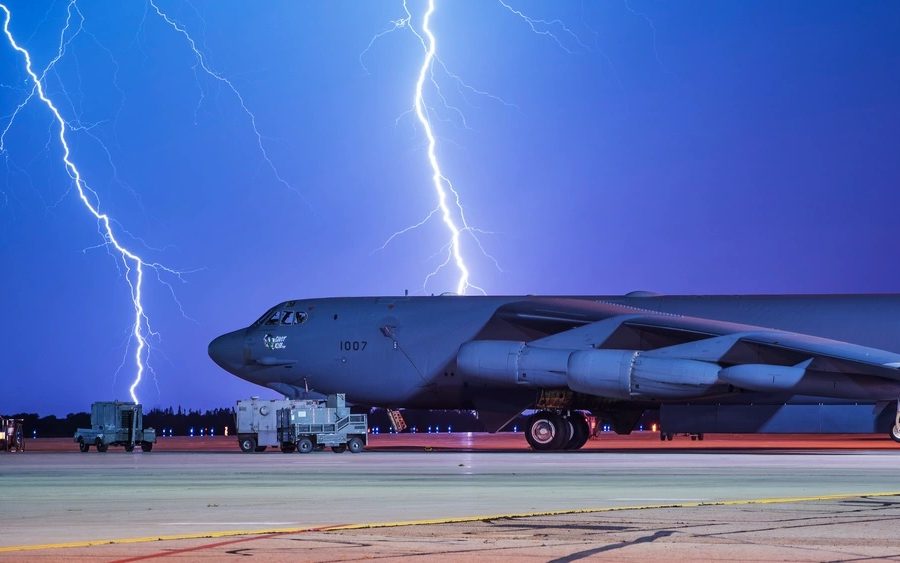The Department of the Air Force revealed a sweeping list of goals and objectives on July 11 meant to keep the service ready to win wars amid severe weather brought about by climate change. The Climate Campaign Plan is the implementation portion of the Climate Action Plan the Air Force unveiled in October 2022.
The goals of the plan include achieving net-zero emissions at Air Force facilities by fiscal 2046, 100 percent carbon pollution-free electricity on a net annual basis by fiscal 2030, testing a full-scale blended wing body aircraft prototype by fiscal 2027, including climate considerations into professional military education by fiscal 2024, and identifying the effects of climate change for select supply chains by the end of fiscal 2023.
This wide swath of goals reflects the scope of the plan. To effectively prepare the Air Force and Space Force for climate change, the plan authors wrote, the department must make its installations capable of withstanding future climate risks, make climate-informed warfighting decisions, and reduce the department’s logistics tail by optimizing energy use and pursuing alternative energy sources.
The announcement also comes as a heat wave scorches much of the western and southern U.S., areas that host many of the Air Force’s largest bases. The climate campaign plan aims to prepare those installations for extreme heat, wildfires, flooding, and other severe weather events exacerbated by climate change.
“We cannot launch or recover aircraft on a flooded runway, nor can we operate from installations devastated by hurricanes and wildfires,” wrote Dr. Ravi I. Chaudhary, assistant secretary of the Air Force for energy, installations and the environment, in the plan’s introduction. “Our bases are our power projection platforms and as those bases are increasingly impacted by the effects of climate change, adapting to these challenges will be critical to meet our national security obligation.”

The plan’s first priority is to “maintain air and space dominance in the face of climate risks,” which entails modernizing infrastructure and facilities to improve base resilience, evaluating the effects of climate change at department installations, and creating installation development plans to prepare for climate risks. Many of the due dates for these steps fall between 2023-2027, but one step is meant to help prepare the Air Fore to meet its 2046 goal of net-zero emission installations. The department must first roll out a framework for achieving that goal by fiscal 2024, then aim to hit 50 percent emissions reductions from 2008 levels by fiscal 2033.
The plan’s second priority is to make climate-informed decisions, which means ensuring “our decisions reflect an understanding of the impacts of the climate on our mission,” Chaudhary said. The steps to achieve that goal include integrating climate considerations into the department’s professional military education curriculum and into Air and Space Force concept development and major/field command operational plans by fiscal 2024.
War games are a part of training, so one of the plan’s goals is to incorporate “best feasible representations of the physical environments for potential future combat operations,” which the plan writers think will better prepare Air and Space Force leaders for real-world missions. The plan also calls for shining a brighter light on the climate-related risks in the Department of the Air Force’s supply chain and incorporating that analysis into its supply chain risk management policy.
The third priority, optimizing energy use and pursuing alternative energy sources, is meant to make the Department of the Air Force’s logistics chains less vulnerable and secure the department’s footing overall by reducing its contributions to climate change. The plan calls for both developing new technologies and maximizing the efficiency of current equipment and facilities.
For maximizing efficiency, the plan lays out a concept called operational energy intensity, which measures how much energy it takes for a unit to accomplish its objectives. Depending on the unit involved, that concept could take the form of test events per gallon, weapons released per gallon, syllabus events per gallon, and even aerial refueling gas offload per gallon. Another term for this conceptual metric is “lethality per gallon.”
The plan calls for increasing the operational energy intensity of Air Force flying missions by five percent by fiscal 2027 and 7.5 percent by 2032, partly through the use of aircraft drag reduction technologies, modern software scheduling tools, and enhanced engine sustainment practices.
On the new technology side, the plan calls for testing a full-scale prototype blended wing body—an aircraft where the fuselage helps the wings generate lift—by September 2027, and completing successful pilots of sustainable aviation fuels that cost the same or less than traditional aviation fuel at two operational Air Force locations by fiscal 2026. Other steps include completing a successful pilot of nuclear micro-reactors by 2028; achieving 100 percent carbon-pollution free electricity on a net annual basis by 2030; and 100 percent zero-emissions non-tactical vehicle acquisitions by 2035.
The plan writers cautioned that achieving these goals will not be possible without developing a set of “cross-cutting capabilities,” the first of which is data collection and analysis. Today, many of the most important data sets for measuring energy and climate risk are managed in “functional stovepipes” which limits the collaboration required to accomplish the plan goals, the writers said. The Air Force will also need to retain systematic sortie-level data on fuel use and create automated processes or systems for collecting infrastructure energy data.
The other needed cross-cutting capability is partnerships with the Office of the Secretary of Defense, the rest of the military, other government agencies, the private sector, academia, and relevant foreign entities.
“Execution of the [Climate Campaign Plan] requires strong partnerships,” the plan writers said. “No single entity can successfully mitigate and adapt to the direct and indirect effects of climate change.”
